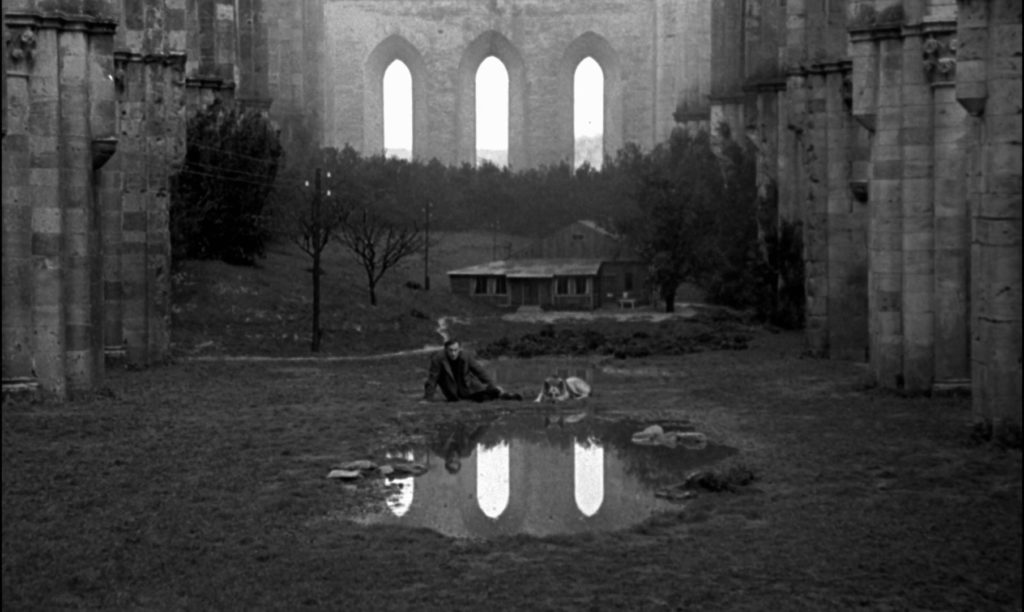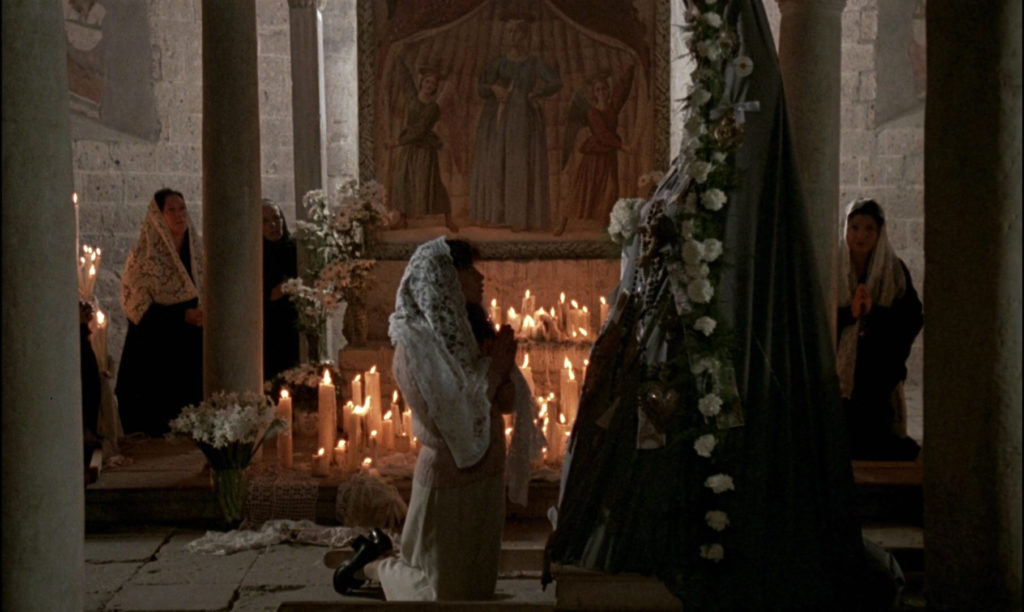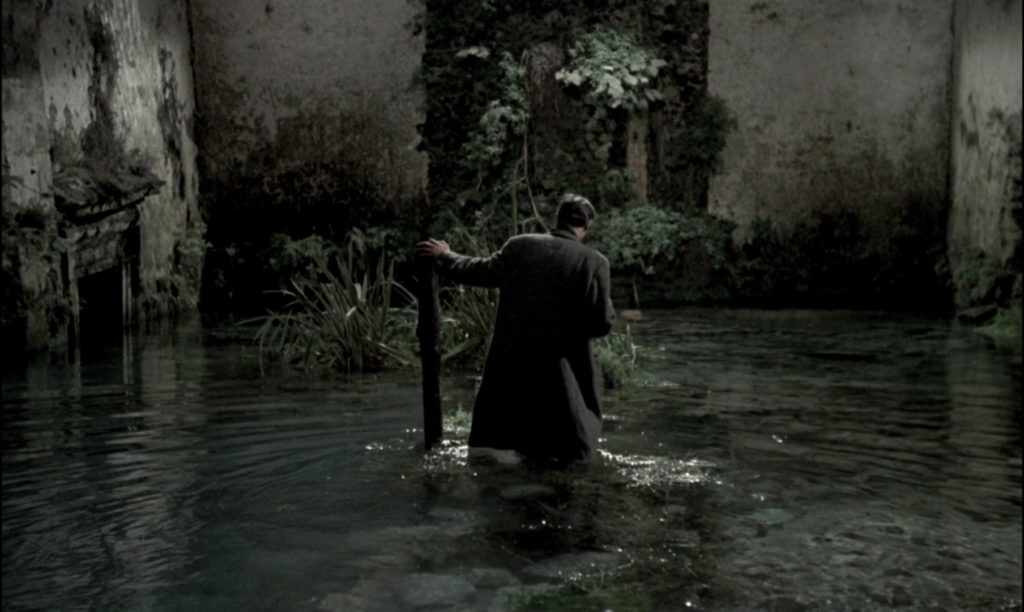| Timothy Zila |

Nostalghia plays at the Trylon Cinema from Sunday, June 20th, through Tuesday, July 2nd. Visit trylon.org for tickets and more information.
The final image of Andrei Tarkovsky’s Nostalghia might encapsulate the filmmaker himself. A man and a dog sit next to a pond—the man leaning to his right, but staring forward with a solemn air. Content and sleepy, the dog lies in the grass, staring straight ahead. There’s a dirt path meandering toward a house behind them. Perhaps it’s their house, this man’s and the dog’s.
This is not a normal, pastoral scene though. The entire landscape is contained within what looks like a giant church or temple. Stone masonry reaches far into the skies. The image is simultaneously naturalistic and unreal. The scope of the temple is cosmic; it is not merely a building, but an entire construct, and the structure seems more metaphorical than literal. But it might be more accurate to say that the metaphor is more real than reality—that is, that it gestures at something bigger and more important than could be contained within a literal stone and mortar building.
The man and the dog remain absolutely still, as if they’re in a photograph or a painting, but the camera moves—pulling backward ever so slowly (as the camera in Tarkovsky’s film so often does). As the man and dog fade into the distance, it begins to snow. The sensation is of two figures frozen in time. And maybe, as we watch, we’re frozen too.
Tarkovsky works in glimpses and memories. Just before cutting to the man and his dog, we were looking at a little boy staring out into the distance (but also, directly into the camera). I have a notion that the little boy was staring at the man and the dog too.
Nostalghia is richly metatextual. At the very beginning of the film, a woman (the frustrated translator of Andrei, the passive protagonist who shares a name with our director) walks alone into a church. Andrei refuses to follow, even though, we later learn, they’ve driven hours in the fog across Italy to get there. He won’t say why he won’t enter the church—he just refuses. The woman wants to look at a painting she’s seen before, a painting that made her cry. She approaches it immediately, but the priest interrupts her viewing. He asks what she’s hoping for (would “praying” be too strong, since the woman does not seem religious?)—babies or to avoid them. She isn’t looking for either of those things.
And then, the priest’s face just inches from the camera and his eyes slanted toward it, he says “If there are any casual onlookers who aren’t supplicants, then nothing happens.” Staged the way it is, I can’t help but feel that this comment is addressed directly to us, the audience. If you’re a casual viewer, Tarkovsky suggests, then this film is nothing and nothing happens in it.
“What is supposed to happen?” the woman asks the priest.
“Whatever you like, whatever you need most,” he says. “But you should at least kneel down.”

This might be as perfect a summation as there is of the commitment required to appreciate so-called slow cinema, of which Tarkovsky is one of the most famous forebears. Paul Schrader goes so far as likening the movement to blackmail: “The slow film director keeps his viewers on the hook, thinking there is a reward, a ‘payoff’ just around the corner. It’s adroit blackmail. If I leave, I’ll miss what I’ve been waiting for … The wait will be worth it.”1
Why, then, do we wait? I’ll be the first to admit Tarkovsky’s film (and many others in the tradition of transcendental film or slow cinema) aren’t entertaining. They aren’t fun. Tarkovsky has made at least two of my favorite films ever (Stalker and Nostalghia, with several others close behind) but I won’t tell you they can’t be boring, or a “slog.” So why wait, why watch?
I think the answer must be personal. Tarkovsky’s films have the potential to be more than cinema—they can be a spiritual experience. As Schrader writes, “The Tarkovsky long shot is more than long. It’s meditative. The psychological effect of slow cinema’s ‘long take’ is unlike any other film technique. Film techniques are about ‘getting there’—telling a story, explaining an action, evoking an emotion—whereas the long take is about ‘being there.’”2
This “being there” involves work on the part of a viewer. We’re used to stories being told to us. That, in a real sense, is what narrative cinema does—telling a story. But that isn’t how Tarkovsky’s films work. Tarkovsky presents us with images, pieces of music, fragments of poetry. Experiencing a Tarkovsky film is a little more like walking through a museum than watching a film—but the pace and structure of a museum visit isn’t dictated by an outside force. And it’s the power of time that Tarkovsky holds as director—the power to hold a shot for so much longer than you expect him to, and so much longer than the story “demands.” What will you do with that time?

Rewatching Nostalghia—particularly, a sequence where Andrei gets drunk inside an abandoned church with a stream running through it—I found myself thinking about a camping trip I took as a kid, where my cousins and I concocted elaborate games of make-believe. I thought of running back and forth along the creeks, stopping now and then to watch water striders glide across the water. And, as a follow-up to those memories, I asked myself when the last time I’ve done something like that … and didn’t have an immediate answer. I thought about how my life has changed; how life changes, as an adult, the things we become obsessed with, or lost in.
I can’t really describe what it’s like to experience a Tarkovsky film, and not just because I lack the words, but because my experience of the film will be inherently different than yours, since it’s shaped by my feelings and memories, my background and sensitivities, and not yours. You might say this is true of any film, and to an extent, that’s correct. But mainstream films work hard to eliminate ambiguity—to produce a story that’s legible and consistent, not meaningfully open to interpretation. And on top of the airtight films themselves, we live in a culture of film writing (“7 theories that explains X,” or “The cast of X spills all”) that seeks to spell out any lingering questions not already explicitly answered by the film.
Tarkovsky is an antidote to all that. The ambiguity is the point. Your own memories are the point. What Nostalghia is “about” in terms of plot—a Russian poet living in Italy while ostensibly working on a biography of a Russian musician who lived in Italy prior to his death—is not what the film is about. The plot may be barebones and conventional (it can be easily summarized in a sentence or two, and there is nothing structurally daring in the premise), but the plot is not the point. “Tarkovsky used film techniques to study time. For Tarkovsky time was not a means to a goal. It was the goal,” Schrader writes. To think about time, I think, is to think about your own experience of time—that is, yourself, your life, your memories.
The question I’d ask myself before sitting down for a Tarkovsky film isn’t “what’s supposed to happen?” but “what do I want out of it?” And like the priest I’d say, whatever you like, whatever you need most. But you should at least kneel down.
Footnotes
1 Paul Schrader, Transcendental Style in Film, University of California Press, 20. Available here: https://content.ucpress.edu/chapters/383001.introduction.pdf
2 Schrader, 8.
Edited by Olga Tchepikova-Treon
